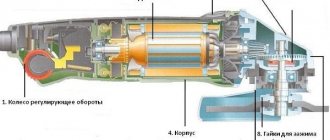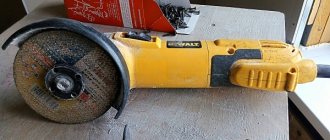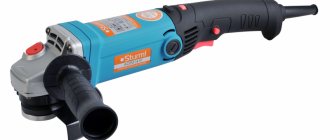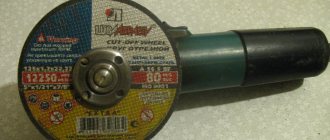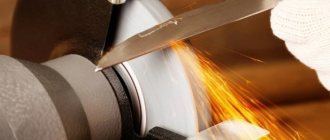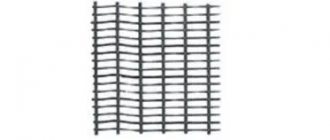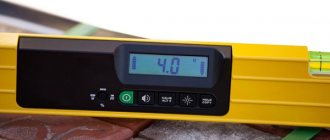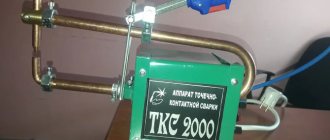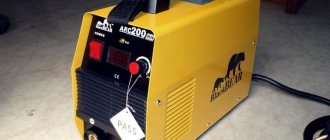A grinder is a power tool that is used in the woodworking and metallurgical industries, as well as during construction work, for abrasive processing, cutting and polishing products made of porcelain stoneware, metal alloys, artificial or natural stone, plywood and other materials. According to the design and principle of operation, the grinder belongs to angle grinders, in which, unlike straight grinders, the axis of the motor and the grinding part is located perpendicular to each other. To choose an angle grinder for construction and finishing work or household needs, you need to pay attention not only to its cost and the type of cutting wheels included, but also other important parameters, for example, the diameter of the disks, the permissible rotation speed, the presence of a speed controller, etc. If you need to purchase an angle grinder, you shouldn’t immediately run to the store and buy the first model you come across. First, we advise you to read the advice of professionals and study the rating of the best angle grinders (angle grinders), in which we will talk in detail about all the pros and cons of different manufacturers and reveal the nuances of the right choice.
How to choose an angle grinder?
Operating principle and scope
An angle grinder is an electric hand tool that is designed for cutting, sanding and grinding materials such as various types of stone, including concrete, metal, wood and others. The construction of an angle grinder is not particularly complicated. However, it is necessary to navigate this issue in order to be able to carry out repairs or preventive cleaning yourself. The durable plastic case contains the following basic elements :
- Speed control wheel;
- Engine;
- Start button
- Frame;
- Quick disk replacement button:
- Safety coupling;
- Protective cover;
- Working disk clamp nut;
- Gear housing;
The principle of operation itself comes down to the conversion of torque, which comes from a spindle connected to the engine via a gear drive. It is to the spindle that various attachments necessary for this or that type of work are attached. The body of the tool is made of high-strength plastic that can withstand impacts. Simply by using different types of attachments, or rather, different types of abrasive wheels, you can perform completely different tasks, which significantly increases the scope of application of this tool.
The grinder is used when necessary:
- Trim or cut out tiles;
- Cut metal sheets or rods;
- Cut grooves in a brick or concrete wall for laying electrical wiring or water pipes;
- Remove rust from a car body or a layer of old paint;
- Sand wooden or metal surfaces to a high degree of smoothness;
- Clean the welds;
- Dull sharp edges with chamfers.
How does an angle grinder work?
All Bulgarians are similar in appearance
All grinders look the same. A commutator electric motor is fixed in an elongated body, the shaft of which is connected to a gearbox. The spindle comes out of the gearbox at an angle of 90 degrees (that’s why the machine is called “angular”). An M14 thread is cut on the spindle; grinding wheels or other attachments are fixed on it.
The name “Bulgarian” took root among citizens of the former USSR. The first angle grinders that came to our country at the end of the 1960s were manufactured in the People's Republic of Bulgaria at the Sparky Eltos factory in the city of Lovech.
The grinding wheel is covered with a protective casing; a handle is screwed to the body, by which the master holds the tool while working. There is also a power button on the case. A lock is required on the side opposite the disk - it prevents the spindle from turning when changing attachments.
Types of grinders
All the variety of this tool can be arranged depending on the type of food. Although the majority of these tools, approximately 95%, are electric, there are four types of power sources.
Network angle grinders
The most common type, operating on 220V voltage. They have the ability to use discs of various diameters. It is advisable to use them in enclosed spaces where there is free access to the network or in areas equipped with sockets. This is the best option for use in an apartment or country house. It is the networked tool that professional electricians, plumbers and tile layers use. Depending on the power, there are both professional models and simpler ones.
Network angle grinders have the following advantages:
- have a high rotation speed;
- are powerful, but at the same time economical;
- for ease of use, there are several options for housing dimensions to suit discs of different diameters;
- affordable pricing policy;
- relatively light weight;
- a variety of attachments that can be used with a specific model;
- long service life with proper use.
The disadvantages include:
- limited use due to energy dependence;
- During operation, the power cord can interfere with the process and create inconvenience;
- you can observe interruptions and instability of the tool in case of a fall
- network voltage.
Cordless angle grinders
Their appearance and body structure have a characteristic difference from network models. At the end of the tool there is a large compartment for attaching batteries. These grinders are produced in modest sizes, and their body serves as the main handle when holding. The size of the disk nozzles does not have such variety as the previous type and lies in the range of 125-150 mm. The battery is a 18V lithium-ion battery. It will not be possible to work continuously with such a tool for a long time. It is rational to use it when it is necessary to perform short-term work in an open area remote from access to power supplies. For example, during the construction of a fence around the perimeter of a work site, during emergency opening of metal doors, or work in country houses without electricity. Despite some limitations, these models have a number of advantages:
- high rotation speed of abrasive discs;
- compact dimensions of the body and the instrument itself;
- For safe storage and transportation, most of these angle grinders are supplied with a case made of impact-resistant plastic by default. This way you save on the additional purchase of that item;
- due to its low weight, it will be very convenient to work; you can make precise cutting or trimming of materials;
- most models are equipped with a number of additional protective functions;
- the presence of an additional side handle significantly reduces the level of vibration, which makes it possible to hold the tool more evenly.
Let's look at the main disadvantages:
- the operating period of the tool is limited by the battery capacity;
- Not all models are equipped with a battery. In some cases it must be purchased separately;
- limited disk size, and, therefore, a limited list of work performed;
- high price.
Gasoline angle grinders
This type of grinder is clearly distinguished by its appearance. Their body has large dimensions. Inside it is placed a fuel tank and an internal combustion engine. Due to its large size, the tool is equipped with a massive frame-handle for easy holding and an auxiliary handle. Gasoline grinders are equipped with large-diameter discs and are used for cutting concrete and iron in places without access to an electrical network. This tool has an increased noise level due to the design of the motor. Work must be carried out using hearing protection.
The advantages of these models are as follows:
- increased power and increased diameter of discs;
- fast cutting of large objects - pipes, profiles, concrete products;
- Autonomous operation thanks to a gasoline engine;
- work can be performed continuously with regular refueling of the fuel tank;
- the presence of a stand that allows you to use the grinder as a full-fledged cutting machine.
Disadvantages of gasoline grinders:
- additional costs associated with the purchase of fuel;
- high noise level during operation;
- work only with nozzles of large diameters;
- due to the large dimensions of the tool, it is not always possible to reach the cutting area in hard-to-reach places;
- to avoid overheating of the engine, regular breaks in operation are necessary until it cools completely;
- high price.
Pneumatic models
They have the same operating principle and purpose as other types of grinders, but differ in internal structure. These models do not have an engine, and the rotation of the nozzles is ensured by a powerful stream of compressed air acting on the blades inside the housing. When the blades rotate, the axis on which the disk is mounted is launched. To operate, a valve is used that allows air flow to the internal channel in the housing. Thanks to this structure, pneumatic angle grinders are the lightest among all possible types. The duration of its work is not limited and can last even the whole day. To operate such a tool, you need access to a compressor that pumps air, or to the air network. Due to such features, pneumatic tools are not used for household purposes. But in metalworking production these models are indispensable. Their advantages
- very light weight;
- due to the lack of a motor, overheating of the tool is impossible;
- The minimum continuous operation time is 6-8 hours. It is limited solely by the human factor;
- replacing bearings, valves and other parts will be inexpensive;
- such models can be used in conditions of high humidity without any risk;
- high rotation speed;
- the operation of the instrument is absolutely silent. The sound appears only at the moment of contact with the surface being treated.
drawbacks :
- high price;
- the need for additional equipment that will ensure the functionality of the tool.
Summarize . To use an angle grinder at home, of course, the optimal type would be a network tool. It is more affordable, has the ability to work with different disk diameters, and is also more economical. By choosing the right size tool you can cope with a lot of tasks. However, if you plan to build a country house or long-term repairs on summer cottages, you should think about purchasing autonomous models that can cut both rebar and concrete blocks. The choice of power type directly depends on the work to be done.
Ergonomic indicators
We also advise you to pay attention to ergonomics when choosing a tool. To do this, you must consider parameters such as the weight of the device, ease of holding, number of handles and ability to dampen vibrations.
Number of handles
In addition to the convenience and safety of using an angle grinder, this characteristic depends. Manufacturers produce two types of power tools - one-handed and two-handed. If you need a model that is easy to handle, then a single-handle tool is your best choice. If necessary, you can easily hold the grinder by the body with your second hand.
More massive versions of grinders, intended for professionals, are equipped with two handles. Their use guarantees secure grip and retention for efficient work. Particularly easy to use are versions equipped with rotary or adjustable handles , which make the tool more maneuverable when working in hard-to-reach places.
Vibration Damping
The same handles, which can dampen up to 80% of vibrations, can solve this problem. It is desirable that these are rubberized handles that are pleasant to the touch. You shouldn’t choose models with hard plastic handles, as they quickly cause pain in the wrist joints, and you won’t be able to work with such an angle grinder for a long time. Although if you are not going to use it for long-term work, then you can easily put up with this drawback.
Tool weight and ergonomics
If you want a tool that is easier to handle, then it should be a lightweight model. Unfortunately, such models are quite rare. Cordless angle grinders, for all their convenience, are much more difficult to handle, since they weigh much more than their electric counterparts. After all, in addition to the basic equipment, they also have batteries installed. Based on user reviews, models weighing up to 3 kg are considered the easiest to use.
To understand how convenient a particular model is, we recommend picking it up in a store, twisting it and turning it on . Sometimes you come across a tool that may be inconvenient for some users due to the special arrangement of handles and buttons.
Tips for choosing cutting blade size
It is the diameter of the disc that is the key factor that determines the scope of work performed by the tool. It is worth noting that the seat diameter for circles has a standard size of 22.2 mm. But, the larger the diameter of the cutting wheel, the higher the rotation speed and power of the grinder. The minimum diameter is 115 mm, the maximum possible is 230 mm.
The diameter of the disc is selected depending on the thickness that will need to be cut. Based on the fact that not the entire part of the circle, but only the part protruding beyond the tool, can be used as a working part, it is necessary to pay attention to the size of the body. For example, if the case is about 60 mm wide, then when using a 125 mm disk it is easy to understand that only half of its surface will work. That is, it will be possible to cut through material no more than 35 mm thick, and in reality even less - 30 mm. After some time, the cutting surface of the disc will wear off, which will significantly reduce this indicator. Using these simple calculations, the required disk size is selected. But it is strongly recommended not to use circles with a larger diameter than allowed by the technical documentation.
To make it easier for you to navigate, let’s look at the types of grinders in more detail, based on the size of the disc:
- An angle grinder of 115 mm is the minimum size for the simplest work. It is most often used for grinding, since cutting at this size is very inconvenient. A smaller diameter means less weight, which means less power. The weight is in the range of 1.5-3 kg, and the power is no more than 1000 W. But the “small” grinder has a maximum speed of 10-11 thousand rpm. It is possible to grip with both one and two hands. The size of the tool does not affect the price, and such a compact tool can have low cost, and vice versa. There are models equipped with many additional functions for professional use.
- 125 mm grinder is the most popular model. It has sufficient power, optimal weight and size for ease of use, and an affordable price. Any store has the most extensive selection of grinding or cutting wheels with a diameter of exactly 125 mm. This is the optimal tool for home use if you do not plan to cut too thick parts.
- Bulgarian on 150 mm – unlike the previous model, it is not in such demand, although it is an excellent alternative option for home use if you need a model that is not small, but not large either. It is convenient to perform both grinding and cutting work. But many argue that a more convenient solution would be to buy separately a small one – 125 mm and a large one – 180 mm. This tool has an average power of 1000-1500 W, an average rotation speed of 8-10 thousand rpm and an average weight of 3-5 kg. "Golden mean" for home craftsmen.
- 180 mm grinder is a suitable option for construction work. The depth of the cut will make it easy to cut bricks (however, you still need to cut on both sides), thick pipes and other elements. This means that doing smaller jobs with such a tool may not be entirely convenient.
- 230 mm angle grinder is the maximum provided by the manufacturers. They call her the “big” grinder. It has a more significant weight - 5-8 kg, a powerful engine - 1500-2000 W, speed - 6-8 thousand rpm. They are equipped with two handles - rear stationary and side with the ability to be installed on different sides of the body. They are expensive, which is justified by the number of built-in functions. With its help, they perform rough work where the use of force is necessary, for example, cutting metal pipes, gating walls for wiring, etc. Such models are absolutely unsuitable for small jobs; even grinding seems unlikely. But for major repairs or construction work, they will come in handy.
Having analyzed the five possible sizes of this tool, it is clear that each has its own advantages and disadvantages. If you are engaged in construction work at a professional level, then the optimal solution for you would be to purchase two grinders. Small – 125 mm for precision work and medium – 180 mm. If you have to do repairs or construction, then a 150 or 180 mm tool is suitable.
Main characteristics of the tool
When you have decided exactly what size tool you need, you can proceed to selecting according to the following parameters:
- The power of an angle grinder is the main indicator of the tool’s performance. The possible power range varies from 0.5 to 2.7 kW, and the increase in power is not directly proportional to the diameter of the working disk. The performance indicator should be chosen according to the same principle as the size - depending on the degree of complexity of the work to be done and its duration. It is clear that using the maximum diameter of the working circle, it is necessary to choose models with a power rating of about 2 kW in order to ensure high rotation speed and increase continuous operation time. But even for small tools with a minimum disc diameter, high power is sometimes needed, especially if you have to continuously grind hard welds for several hours. A small tool with a power rating of 0.5-0.9 kW is considered household and is quite suitable for a small amount of work that does not involve lengthy cutting of pipes or grinding of concrete surfaces. For heavier work, models with a power of 1 to 1.5 kW, which are classified as professional, are suitable. For construction work, it is preferable to use grinders with a power of 1.3 to 2.7 kW.
- Rotational speed The angle grinder ranges from 6000 to 15000 rpm. It is believed that the higher this indicator, the faster you can perform grinding work or clean the surface from rust and other contaminants. In practice, this indicator for each tool is selected individually depending on its weight and is optimal. The only thing you need to know is that the angular speed of rotation depends on the diameter of the working disk. Therefore, for large grinders it is preferable to have a speed control function. When erasing the working edge, this indicator must be reduced, thereby normalizing the speed of angular rotation. For domestic use, a tool with a minimum speed of 6000 rpm is sufficient. If there is construction ahead or work that includes polishing wooden surfaces or making wooden fencing, you will need a model with an indicator of 7000-11000 rpm. For cleaning car bodies and other metal surfaces, choose a tool with a speed of 15,000 rpm or more. These can often be seen at service stations.
- The weight of the tool determines the duration of the work. Don't forget that working puts stress on your arms and back. The lightest tools, whose weight starts from 1.2 kg, are suitable for daily work lasting no more than 4 hours. Medium grinders weighing from 3 to 4 kg are suitable for work for 2-3 hours every day. For heavy work, it is necessary to choose larger models that will cope with the task faster and do not require much effort from the operator. Their weight is 6-9 kg.
- Number of handles. Grinders can be one-handed or two-handed. This immediately catches your eye when visiting specialized stores. All models have a main handle, which is screwed into the spindle itself and can be rearranged on different sides of the body. This makes working with the tool equally convenient for both right-handers and left-handers. The second handle is either the body itself or an additional handle at the end. This makes it possible to hold the tool with both hands if necessary. The choice of the number of handles is again based on the nature of the work to be done. It will be equally convenient to carry out cutting work with a tool with one handle or with two, but it is dangerous to perform grinding work with a one-handed tool. During operation, the grinder can skid strongly and even a physically strong person will have difficulty holding it. Therefore, when choosing powerful models for grinding, look only at two-handed ones. Grinders for fine grinding of low power can also be one-handed. The main handle should preferably have finger protection for large instruments and an extension at the top for small ones. This will prevent the tool from slipping out of tired or sweaty hands. The auxiliary handle should be mushroom-shaped and ideally be able to twist in several positions. This will make working with the grinder as convenient as possible. Both handles must have a rubberized coating.
- or capacity . Gasoline models have a tank volume of 0.7 to 1.5 liters. If you have the opportunity to carry an additional canister of fuel with you, then this indicator does not matter. Cordless angle grinders have a battery capacity of 2-4 A/h. Thanks to this, the spindle rotation speed reaches up to 11,000 rpm. Accordingly, the larger the capacity, the longer the operating time of the tool. For short-term work, the minimum indicator is sufficient.
- Air pressure and speed – for pneumatic models. Speed is important in maintaining a high RPM. This figure reaches from 100 to 540 liters/min. The larger the disc diameter, the higher the feed speed should be. The pressure reaches from 6 to 6.5 atmospheres.
Needs assessment
When choosing an angle grinder, pay special attention to the diameter of the disc. It should perfectly match the tasks you face. And it is with this characteristic in mind that you need to purchase the instrument itself. If you buy a larger disc , then you will have to automatically look for a tool model equipped with a more powerful motor for it. This will make the device heavier and more difficult for you to handle.
Engine power
This is one of the most important characteristics on which the performance of an angle grinder depends, as well as its stability under load conditions. The varieties offered in stores are equipped with power drives with power from 0.5 to 2.6 kW. If you choose a tool for solving everyday problems, then a model with a power of 0.6 to 1 kW will be enough for you.
If you decide to install heavy wheels on such a low-power angle grinder, its rotation speed will immediately drop. Therefore, you must remember that an angle grinder on which a larger diameter disk is installed may, in practice, turn out to be low-power and ineffective.
Spindle speed
Most tool models designed to work with large discs have a rotation speed of 7-9 thousand revolutions per minute. For small-diameter discs, manufacturers produce tools with speeds of up to 12 thousand.
Please note that the number of revolutions indicated on the device refers to operation in idle mode. During operation, the actual rotation speed will differ from the declared one downward. In addition to modifications of the standard version, you can purchase a tool with a manual regulator, which allows the master to manually adjust the rotation speed.
Useful additional features
More expensive models are equipped with a number of additional features. For example:
- Case It will be very useful if you plan to frequently transport the instrument, or simply for storage and protection from dust and accidental impacts. The grinder must be securely fixed in special recesses. The case can accommodate all the necessary keys and disks.
- soft start system allows you to minimize the load on the engine. When you turn on the tool, the rotation speed will be minimal, gradually increasing. This will protect the internal elements of the gearbox from a sharp impact and from biting the disk in a hard surface. Accordingly, such a tool is easier and more convenient to use.
- Locking the start button also makes work much easier. There is no need to constantly hold the power button pressed, which always quickly tires your hands. Using a small additional button located next to the trigger, you can lock it in the on position.
- Adjustment of disk rotation speed - this function is present in expensive professional models. You can independently set the required rotation speed depending on the work being performed and the diameter of the working disk. This will eliminate the need to purchase multiple tools. But if you do not have the skills to work with an angle grinder, difficulties may arise in independently selecting modes, and the end result will not live up to expectations. You may end up with crooked cuts and other troubles.
- Stabilization of the speed depending on the load on the disk. This function is useful regardless of the user’s skills. The tool automatically selects the optimal rotation speed and optimizes the work process. It is very useful when working with heterogeneous materials that have a soft outer coating and a hard core or vice versa. The electronics recognizes the load change and instantly adjusts the speed.
- Dust protection is very important when working on concrete surfaces. The gearbox and shaft will be reliably protected from the ingress of small abrasive particles. The service life of the grinder depends on this. Models with this function are very expensive, so if you are not involved in construction, then at home you can do without it.
- Automatic disk balancing is inherent in very high-quality instruments. The point is that angle grinders smooth out the runout that occurs when the working edge of the disk is unevenly worn. This is very useful for polishing work. You will notice the difference in working with the tool with and without this function within an hour.
- The ability to connect a construction vacuum cleaner makes work more comfortable and allows less pollution of the surrounding space, the tool itself, and the worker’s respiratory tract. This is an alternative to the built-in dust protection function at a more affordable price.
- Automatic power outage will be useful during power outages. If the light goes out during operation, the machine will work, turning off the power to the angle grinder, and it will not start rotating when the power supply is restored.
Summing up
An angle grinder is undoubtedly a useful tool that every owner would benefit from having. The problem is that choosing the right model is not so easy. Many people forget that any complex device must be selected correctly, paying attention to the performance characteristics it contains. And with the grinder you need to do the same . Indeed, today there are so many varieties of this power tool offered on the market that it is very difficult to choose the appropriate option without first studying their capabilities and comparing them with each other.
Therefore, you need to consciously approach the issue of choosing this unit and first of all determine for yourself the scope and list of tasks that you are going to perform with the help of an angle grinder . Not only its performance characteristics , but also its price will depend on this. Although it is not recommended to save on such a tool, the price factor still needs to be taken into account.
To make the task easier for yourself, we recommend that you familiarize yourself with the ratings of popular models and reviews from real consumers. This is exactly what many owners do when they have doubts.
Proven brands and price range
To buy a reliable tool that will serve you for many years, you should consider only trusted manufacturers and do not skimp when purchasing. After analyzing reviews from ordinary consumers and professional users, we have identified several of the most popular brands:
- STURM is a proven co-production company from Germany and China. We can highlight one of the popular models that is suitable for home and country use - AG9512P. The diameter of the working disk is 125 mm, while the machine produces a power of 1 kW with a speed of 4 to 11 thousand rpm. It has a comfortable weight - only 2.5 kg and an affordable price - about 3800 rubles. equipped with additional functions such as speed control, soft start, and anti-jamming protection. The handle can be installed in three different positions.
- Makita is a well-known brand for the production of hand tools. Made in Japan, there are factories in China and Romania. An inexpensive but high-quality model that is suitable for both home and professional use is model 9555 HN. The disk diameter is also 125 mm, the power is slightly lower - 0.71 kW. The speed reaches 10 thousand rpm. This model is lighter - 1.9 kg, but is not equipped with any additional functions. Its cost is about 3600 rubles.
- Metabo , Germany. For heavier construction work, which involves processing stone or concrete, the W 2000 model is suitable. It has a maximum working disk diameter of 230 mm, an impressive power of 2 kW and a weight of 5.8 kg. The speed is about 6.6 thousand rpm. Equipped with a premature start protection function. The price of this model is about 6900 rubles.
- DeWALT – doesn’t even need a description. Made in USA. Among the more powerful and professional models, we can highlight the medium-sized model - D 28136. The disc diameter is 125 mm, the power reaches 1.5 kW, and the speed ranges from 2.8 to 10 thousand rpm. The tool weighs 2.6 kg. Sold complete with a case, it has a speed control function, soft start and protection against intentional starting. For one-time use at home it has a high price - 7800 rubles, but for professional use it is optimal.
- Sparky is a real “grinder”, made in Bulgaria, where the name comes from. Among the entire model range, the M 850E model is the most suitable for home use, reliable and compact. Its weight is 2.4 kg, the diameter of the working circle is 125 mm. The machine has a power of 0.85 kW and a speed of rotation from 3 to 10 thousand rpm. Equipped with speed control function and soft start. The price is about 3,700 rubles.
- Among domestic manufacturers, we can highlight the Energomash and its model UShM-9512P, which is suitable for work in an apartment or in a country house. This model is not recommended for continuous operation over a long period of time; there is a risk of overheating. The tool weighs 2.5 kg, has a power of 0.85 kW and a rotation speed of 3-10 thousand rpm. Disc diameter 125 mm, price around 3,700 rubles.
- "SPECIALIST" - another worthy representative of domestic production. The BShU-1050 model is distinguished by its low cost - only 2100 thousand and a good price/quality ratio. Suitable for small jobs around the house. Does not have additional functions. Working diameter is 125 mm, power is 1.1 kW. Speed 11 thousand rpm. Machine weight – 2.3 kg.
When choosing such a necessary tool, you should not buy it in unknown places. It’s better to go to a specialized store, be sure to check the functionality on site, carefully inspect all connections, check whether there is a guarantee and what the product is equipped with. Pay attention to the start button, or rather its size. It should be large enough so that even with rough gloves you won’t have any difficulty turning it on.
The best angle grinders with a disc diameter of 115 mm
Grinders with a disk diameter of 115 mm are used for grinding and forming cuts up to 25 mm deep. Angles in this category are one-handed, small in size and equipped with a side handle.
| DeWALT DWE 4150 | Black+Decker G650 | |||||||
| Power, W | 900 | 650 | ||||||
| Weight, kg | 2 | 1,84 | ||||||
| Speed, rpm | 11800 | 11000 | ||||||
| Availability of vibrating handle | ||||||||
| SDS quick release nut | ||||||||
| Adjusting the housing position without tools | ||||||||
| Electr. speed adjustment | ||||||||
DeWALT DWE 4150
The DeWALT DWE 4150 produces 900 watts and 11,800 rpm and has good ergonomics and a low profile design. Dimensions – 390*120*150 mm. The brush holder is spring-loaded and independent, which increases the time of maintenance-free operation of the brushes.
+ Pros of DeWALT DWE 4150
- Lightweight and easy to use.
- Hardy, able to withstand significant loads.
- Power declared by the manufacturer
- Moderately noisy.
- The motor armature is coated with a protective epoxy coating to protect the motor from dust.
- The brushes are self-switching, preventing damage to the armature.
- low vibration level.
— Cons of DeWALT DWE 4150
- Weak side handle.
- Short power cable.
- The disk fastening is non-standard, using a hexagon. This may be inconvenient the first time you use it.
Conclusion. The areas of application for this angle grinder are housework or small production. It is good to use in places where precision processing is required and for body work. Spindle lock button on top, which ensures maximum cutting depth.
Black+Decker G650
The power of the Black+Decker G650 is 650 W, 11,000 rpm. Dimensions – 310*134*115 mm. The thickness of the case is slightly larger than the standard one, but the weight is only 1.84 kg. The handle is two-position, can be installed on the left or right side. Standard spindle lock for disc replacement.
+ Pros of Black+Decker G650
- Combination of ergonomics and weight.
- Quiet engine operation.
- Soft start, no jerks.
- Fits comfortably in the hand.
- Has sufficient power.
- Good vibration damping.
— Cons of Black+Decker G650
- Short power cord.
- Thin plastic handle.
- According to reviews, in rare cases there is no lubrication on the gears of the gearbox; if the gearbox makes a lot of noise when turned on, you need to disassemble the tool and lubricate the gears or replace it under warranty.
- There is no speed control, the start button is wobbly, but responds well to pressing.
Conclusion. This angle grinder is a convenient option for the home workshop, for short jobs. It is not recommended to use it in production due to its low wear resistance. With timely maintenance and repair it will last a long time. For convenience, you can extend the power cord. After purchase, it is recommended to check the model - there should be no strong noise or unpleasant odor during operation.
